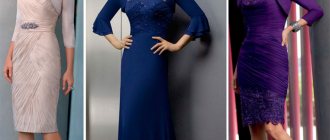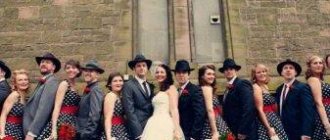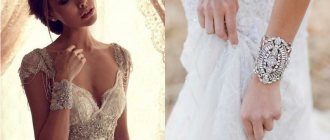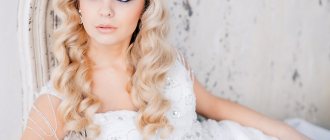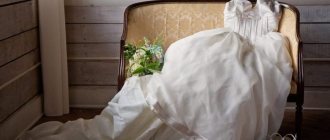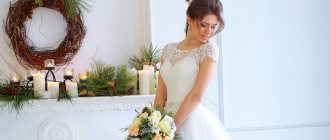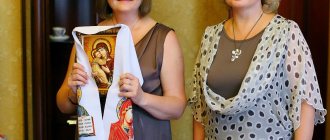Home / Fashion and style / Dresses
Muslim wedding dresses are incredibly elegant and feminine. Regardless of fashion trends, traditional decoration retains its distinctive features and at the same time looks chaste, but luxurious and charming.
Basic requirements for an outfit
The main requirement that is put forward when choosing a Muslim wedding dress is that the silhouette is hidden from prying eyes and discreet. The entire body (except for the face, hands and feet) must be carefully hidden. Openness of the shoulders, neck, and arms of a Muslim woman is unacceptable.
Floor-length, with a collar and long sleeves, traditional Muslim wedding dresses amaze with their exquisite detailing. Unusual decorative elements and intricate embroidery make wedding dresses for Muslim women a work of art. The outfit is made only from the best, high-quality, expensive fabrics (for example, silk or satin). The use of transparent materials is unacceptable.
A requirement that is unquestioningly fulfilled when choosing a wedding look for a Muslim bride is the presence of long sleeves (sometimes in combination with gloves) and a high collar.
The color of the bride's outfit is not tied to any canons. If desired, clothes can be either traditional white or other shades. The most relevant this season are: powdery, peach, golden, silver colors. For the young and stylish, a dress in rich colors is ideal. In Muslim countries, the image of a bride in red is welcomed. According to the strict rules of Sharia, the head must be covered. You can choose to complement the look with a veil or hijab.
The main differences between a traditional Islamic wedding dress are:
- regardless of the time of year and weather, the outfit must cover all open areas except the face, hands and feet;
- overly tight silhouettes are prohibited;
- rich decor;
- the infinity of colors of a Muslim wedding dress;
- It is mandatory to have a headdress that hides the bride's hair.
What color do modern Muslim brides prefer?
The most popular color for oriental wedding attire is white. It symbolizes purity and innocence, which is why traditional dresses in both Muslim and European cultures are usually created from snow-white fabrics. However, this is not a mandatory requirement for wedding decoration. The dress of an oriental beauty can also be made in delicate pastel colors: pale pink, peach, turquoise, beige, caramel, silver.
Modern fashion also allows ensembles of more saturated and bright colors. In the collections of designers there are deep blue, lilac, violet, emerald and even red models. Thanks to their delicate cut, such models do not look provocative or aggressive, but only emphasize the delicate beauty and elegance of the bride.
Varieties
The limits of what is permitted in choosing a Muslim dress for a wedding are determined by each nationality professing the religion of Islam. For some, deviations from strict requirements are possible, while in others a girl can only choose a closed white dress.
But, despite the restraint of the style of Muslim wedding attire, the bride’s dress is a work of art that is often passed down from generation to generation. The dress is embroidered with pearl beads and precious stones, and embroidered with silver or gold threads.
The silhouette is carefully selected. At the same time, the strict outfit subtly emphasizes the femininity of the Muslim bride.
A few secrets of choosing a Muslim wedding dress:
- slender girls will appreciate the “fish” silhouette that outlines the hips and narrow waist;
- Brides with curvy figures should choose dresses with full skirts.
Traditional
The classic dress of a Muslim bride combines a straight, slightly fitted silhouette, long sleeves, and a closed neckline. The not tight, but delicately elegant silhouette very carefully emphasizes the female figure. It is in this form that a girl can look both strict and femininely attractive. The dress is made from high-quality, expensive fabrics (satin, silk) with the addition of textured openwork fabrics (for example, guipure).
The traditional image of a Muslim bride is impossible without a skillfully embroidered silk scarf (hijab) that hides her hair and ears.
Lush multi-layered
Airy, amazingly beautiful dresses with a multi-layered chiffon-based skirt will help you create an attractive, stylish and very fashionable look. The skirt of the dress is made of chiffon, gathered in layers in the shape of a rosebud. In combination with embroidered pearls and beads on the bodice, you get a very stylish, amazingly beautiful outfit.
A-line
The fitted bodice and widened hem of the dress help to gracefully and very delicately outline the graceful figure of the bride. The skirt widens from the waist. A-line dresses are preferred by Muslim brides, noting the amazing combination of modesty and grace in such a dress. The outfit is decorated with gold or silver embroidery and complemented with a long train.
Fitted
A fitted lace dress amazingly emphasizes the youth and innocence of the bride. Covered shoulders and arms soften the eye-catching lines of the female figure, making the bride's image more elegant and sophisticated. It is worth noting that the fitted silhouette is extremely trendy this season. Precious stones and beadwork add luxury to the dress. Convex decor creates a unique three-dimensional effect on clothes. The fitted silhouette is often complemented with a fish skirt. This image looks very gentle, without violating the strict Muslim canons of women's clothing.
Dress models
Not every style of dress can be suitable for a girl who professes Islam. For example, she should not wear short, open or translucent models. All this can cause indignation among guests and discredit the young beauty.
The wedding must be carried out according to all traditions.
There are two types of traditional dresses:
- Strict models. With their help, it is possible to emphasize the girl’s modesty, humility and devotion to her future husband. Dresses are characterized by a closed neckline, long sleeves, and a loose silhouette. There is no bright embroidery, beads or rhinestones. If decorations are present, they are almost invisible symbols that traditionally signify the happiness of family life and fertility. At the same time, these outfits look especially elegant and sophisticated.
- Elegant models. Completely closed, but at the same time rich in various decorative elements. Bright embroidery, an abundance of beads and rhinestones, flowers, lace - everything is here that makes the outfit even more beautiful. In such excellent attire, the young girl will pay tribute to traditions and at the same time will be able to stand out perfectly from all the guests present.
Styles of Muslim dresses
- Lush. These luxurious styles feature layered and voluminous hemlines. The skirt is decorated with chiffon, giving the bride a special airiness.
- A-silhouette. An unobtrusive and ideal dress for Muslim women. It follows all the strict canons, as it does not highlight the silhouette too much, but at the same time allows the girl to remain feminine. Models can have different colors and are complemented by beautiful embroidery.
- Fitted. A rather bold image is suitable for modern girls who are not afraid to stand out. Models must be completely closed and are often decorated with lace.
Modern girls not only pay tribute to traditions, but also want to look more interesting. It is for them that designers create luxurious and exclusive outfits.
Some brides may choose to wear layered chiffon or pantsuits, but it depends on how much she wants to embrace tradition.
Decor options
Muslim wedding dresses, the photos of which are striking in their beauty, are distinguished by their rich decor. Decoration with precious stones, beads, rhinestones and pearls, sewing with gold and silver threads create shimmering three-dimensional patterns throughout the dress. Guipure lace fabric embroidered with beads is especially popular among Muslim brides. The decor can be either one color or multi-colored. This helps create amazingly beautiful intricate patterns.
European trends in wedding fashion make small adjustments to the outfit of a Muslim bride. The outfit can be complemented with a neat stand-up collar (ideally emphasizing the beauty of the neck) or a light corset (emphasizing the bride’s thin waist). Muslim brides also liked asymmetrical sleeves. Elongated at the back and slightly shortened at the front, they allow you to delicately demonstrate a girl’s graceful hands without violating strict rules.
Jewelry and headdress
The main accessory that complements the image of a Muslim bride is the hijab headdress. According to strict canons, only the future spouse and immediate family are allowed to see the hairstyle of an Islamic bride. During the wedding celebration, the head must be covered with a hijab. This lightweight scarf is made from flowing silk fabric. The hijab is skillfully decorated with embroidery with gold threads, lace, and precious stones.
As an option, instead of a hijab, the bride’s head can be covered with a wide scarf or scarf, or a veil with a veil.
For a wedding, an Islamic bride can choose the following accessories:
- a small elegant bouquet of flowers;
- a miniature handbag, matching the dress in color and decor;
- jewelry: bracelets, rings, necklaces. Fine jewelry decorated with precious stones not only decorates the bride’s outfit, but also determines the status of the groom’s family. Earrings are included in the bride's outfit only if she wants to show them to her husband. To outsiders, the earrings are hidden under the fabric of the hijab.
There are no strict rules for choosing shoes for the wedding look of a Muslim bride. The main thing is that it is comfortable (the wedding ceremony is quite long) and closed (the shoes support the overall style of the Muslim wedding attire).
Classic and restrained does not mean boring and faceless. Despite existing restrictions and prohibitions, Muslim wedding fashion has many faces and gives every bride the opportunity to choose the perfect wedding dress.
How Muslim women get married: details of appearance
Girls in Islam are, in principle, very different from Europeans and our compatriots in mentality, but we should not forget about their appearance. Islam is a very strict religion, especially for the fair sex. And strict rules apply to appearance, including at a girl’s own wedding. The bride's Muslim attire and her image must be selected in accordance with certain “regulations”.
Muslim dress for the bride should be closed
Every Muslim bride's wedding outfit is a special item of clothing intended for a special occasion, so there may be some exceptions. However, it is subject to the same Sharia requirements as all women's clothing:
- the fabric should not be translucent so that the contours of the body can be seen through it;
- the arms, back, shoulders, neckline, and legs of the bride should not be exposed.
Muslim wedding dresses can be more revealing and revealing if men and women celebrate the wedding separately. In this case, the bride may feel more relaxed. But she is obliged to cover her head and cover the exposed parts of her body with a scarf or cape before any man sees her. Also, you should not try on an open wedding dress in a salon if men are present there or can see a girl from the street.
Muslim brides look truly luxurious even in closed wedding dresses. Typically, outfits are decorated with lace, embroidery, beads and crystals. Therefore, every future wife in Islam feels like a real queen on her wedding day.
Hijab is a must
Literally, hijab for Muslim women is a wide headscarf that women use to cover their body and hair. Today this concept for most Europeans means a headdress, in particular. Muslim brides not only wear hijab every day, but also wear it to their wedding.
Muslim wedding dresses usually come with a hijab so that both elements of the look are combined with each other. A wedding headdress consists of several parts - a cap, which fixes the hair and covers the hairline, as well as a scarf, which is tied in a special way. The scarf is usually decorated with various decorative elements, just like the dress. In addition, Muslim brides can make their hijabs even more beautiful by attaching a veil, a brooch, or covering them with another thin, beautiful scarf.
Manicure of a Muslim bride
Women in Islam are not recommended to cut their nails short. But it is not advisable to cover your nails with varnish. After morning and evening prayers, when Muslims wash their hands, the varnish prevents water from getting on the nails, so the prayer is considered incomplete.
In fact, a Muslim bride can paint her nails, but she will have to wash and apply nail polish several times a day. If her future husband, as well as close family members, do not mind, the girl can use varnish.

